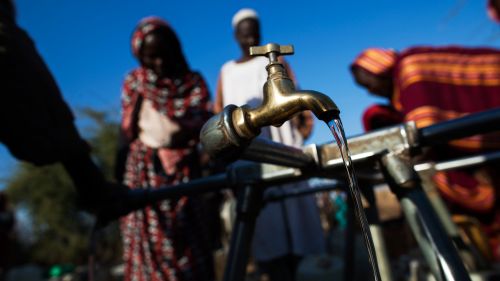Threats to Supply Chains in the Developing World

Threats like water scarcity, urbanization, and climate change require governments to be flexible, and to build flexibility into their institutions.
Global Water Consumption
Global water resource security poses a serious threat to the world’s population, even before we even factor in the effects of climate change. The global water consumption rate is double the rate of population increase. Demand is expected to outstrip supply by more than 50 percent by 2025, leaving 1.8 billion people in water scarce conditions. This trend has been driven chiefly by unsustainable agricultural water extraction, especially non-renewable groundwater pumping and flood irrigation, as well as increasing urbanization, as city living is associated with higher per capita water consumption. Adding climate change to this mix does not improve the picture.
The exact effects of climate change on the food supply in the developing world are difficult to predict. In part, this is because they interact with a broad range of geographic differences, social conditions, and land use patterns. In general, however, it is clear that there will be a lot of suffering and that it will be disproportionately borne by the people least able to shield themselves from the impacts of climate change: scarcity, environmental damage, and extreme weather.
Climate Change Means Less Reliable Farming and More Food Insecurity
The changing climate will negatively impact water resource security and agricultural production for parts of the world already struggling with scarcity. For instance, this winter's pronounced El Niño has contributed to a severe drought in Southern Africa. More severe and common El Niño events are a likely consequence of climate change. The current science suggests spatiotemporal changes precipitation—in particular stronger seasonal patterns, with drier dry periods and wetter wet periods. Much of the developing world’s food is regionally produced (more than 80 percent in Africa) and rain-fed, making food security especially sensitive to climate change.
Meanwhile, more intense rain events associated with climate change will bring too much water to already wet places. This can be just as destructive in ways that go beyond direct damage to property and crops from flooding and intense storms. If flooding is related to rising sea levels, as in Vietnam’s Mekong River Delta, it can create seawater intrusion into farmland, permanently ruining land by raising soil salinity. Higher water temperatures and pollutants flushed into water systems from strong rain events also degrade water quality and threaten ecosystem stability.
Urbanization, Water, and Climate Change
Cities, even though they consume a much smaller portion of water when compared to agriculture (70 percent vs. only 8 percent), are where most people live. Thus, the very same consolidation of infrastructure that makes water more reliable for urban dwellers puts more people at risk when it fails or cannot be adequately supplied. Urbanization creates its own forms of water stress via increasing per capita water consumption and rising incomes, as wealthier people use more water, energy, and water-intensive goods. Simultaneously, the urban poor in the developing world can face inadequate access to drinking water and basic sanitation. Cities in the developing world are, in other words, sites of both acute scarcity and high consumption.
Urbanization also increases the demand for power generation, which itself requires a lot of water. This water-energy nexus is really a water-energy-food nexus, because a large portion of the energy (30 percent) and water consumption (70 percent) is required to feed a rapidly growing and urbanizing population. If the power sources for this are carbon-intensive, they will further sharpen the effects of climate change.
There are already serious perennial and seasonal water shortages in many cities in the developing world, which climate change is expected to exacerbate. On their current trajectories, water and energy consumption will increase competition between urban and rural populations for the same pool of resources.
The Difficult Path Forward
Unsustainable water use has been essential to both urban and agricultural growth everywhere in the world. Climate change accelerates our reckoning with this fact. Confronting this reality will likely bring necessity and fairness into conflict. The extraordinary confluence of problems requires an honest accounting of what can and must be done to protect the most vulnerable people.
Agricultural producers must adopt more water efficient irrigation methods, use less fertilizer, and shift to crops that require less water, or can handle brackish water. In some cases this should involve pricing and rights-transfer schemes to encourage conservation, paired with water user groups to help smallholders navigate them. Governments can help all this by not subsidizing water intensive crops which offer short-term economic benefits at the expense of long-term stability.
Cities, meanwhile, can be very efficient in their water use if they want to be, as places like Los Angeles and Amman, Jordan have shown. Among the most important efforts here across sectors is improving infrastructure to prevent the staggering amount of purified water lost through leaking pipes—estimated to be 40-50 percent in the developing world.
The uncertainties of the climate future require governments to be flexible, and to build flexibility into their institutions. More shared governance of water sources, dictated by hydrologic boundaries rather than national ones, would be a useful step toward resource security. It may even reduce potential scarcity-related conflict.
All of these things take time, however, and the pressures of urbanization and climate change will not wait. The burdens in transition will fall most heavily on people in the developing world, especially the poor. Dealing with the water crisis, and the potential food and energy crises that it engenders, is a global problem. This is at least because we all share responsibility—even more strongly in the developed world—for the causes of climate change. Without an intense effort, and perhaps even with it, there is substantial potential for water scarcity to be a major destabilizing force in the developing world.

